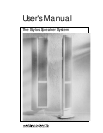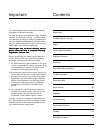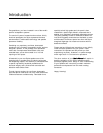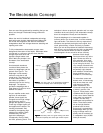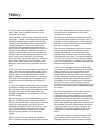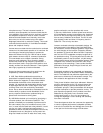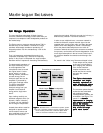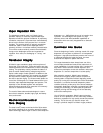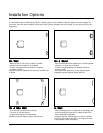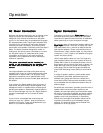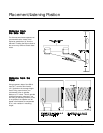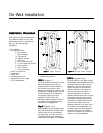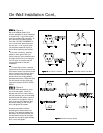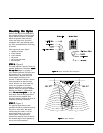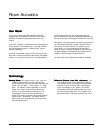
Page 8
Stylos User's Manual
Martin-Logan Exclusives
Full Range OperationFull Range Operation
Full Range OperationFull Range Operation
Full Range Operation
The most significant advantage of Martin-Logan's
exclusive transducer technology reveals itself when you
compare it to examples of other loudspeaker products on
the market today.
The Stylos uses no crossover networks above 700 Hz
because they are not needed. It consists of a single,
seamless electrostatic membrane reproducing all
frequencies above 700 Hz simultaneously. How is this
possible?
First, it is important to understand that music is not
composed of separate high, mid and low frequency
pieces. In fact, music is comprised of a single complex
waveform with all frequencies interacting simultaneously.
The electrostatic transducer of
the Stylos essentially acts as
an exact opposite of the
microphones used to record
the original event. A micro-
phone, which is a single
working element, transforms
acoustic energy into an
electrical signal that can be
amplified or preserved by
some type of storage media.
The Stylos
electrostatic
transducer transforms
electrical energy from your
amplifier into acoustical
energy with a single mem-
brane.
Upon looking carefully at a
traditional magnetic driver (I.e.
dynamic, ribbon, induction),
no single unit can reproduce
the full range of frequencies.
Instead, these drivers must be
designed to operate within
narrow areas of music and
then combined electrically so
that the sum of the parts
equals the total signal. While this sounds nice in theory, a
different story unfolds in real-world conditions.
In order to use multiple drivers, a crossover network is
enlisted to divide the complex musical signal into the
separate parts (usually highs, mids, and lows) that each
specific driver was designed to handle. Unfortunately,
due to the phase relationships that occur within all
crossover networks and during the acoustical recombina-
tion process, nonlinearities and severe degradation of the
music signal takes place in the ear's most "critical zone",
the crossover between the tweeter and midrange.
See
Figure 1
.
So, music in the "critical zone" becomes delayed in time.
These delays can be picked-
up by your ear and result in
poor imaging and ambience
cues. Voices lose their
complex harmonies and
sound less like the vocalist
and more like a stereo
speaker.
The Stylos electrostaticThe Stylos electrostatic
The Stylos electrostaticThe Stylos electrostatic
The Stylos electrostatic
transducer can single-transducer can single-
transducer can single-transducer can single-
transducer can single-
handedly reproduce allhandedly reproduce all
handedly reproduce allhandedly reproduce all
handedly reproduce all
audio frequencies aboveaudio frequencies above
audio frequencies aboveaudio frequencies above
audio frequencies above
700 Hz simultaneously.700 Hz simultaneously.
700 Hz simultaneously.700 Hz simultaneously.
700 Hz simultaneously.
The crossover phase disconti-
nuities that are associated
with traditional tweeter,
midrange/woofer systems are
eliminated in the Stylos. This
results in a
dramaticdramatic
dramaticdramatic
dramatic
improvement in imagingimprovement in imaging
improvement in imagingimprovement in imaging
improvement in imaging
and staging performanceand staging performance
and staging performanceand staging performance
and staging performance
due to the minutelydue to the minutely
due to the minutelydue to the minutely
due to the minutely
accurate phase relation-accurate phase relation-
accurate phase relation-accurate phase relation-
accurate phase relation-
ship of the full-rangeship of the full-range
ship of the full-rangeship of the full-range
ship of the full-range
panel wave launch.panel wave launch.
panel wave launch.panel wave launch.
panel wave launch.
Critical ZoneCritical Zone
Critical ZoneCritical Zone
Critical Zone
700 - 20kHz700 - 20kHz
700 - 20kHz700 - 20kHz
700 - 20kHz
TweeterTweeter
TweeterTweeter
Tweeter
MidrangeMidrange
MidrangeMidrange
Midrange
WooferWoofer
WooferWoofer
Woofer
Critical ZoneCritical Zone
Critical ZoneCritical Zone
Critical Zone
700 - 20kHz700 - 20kHz
700 - 20kHz700 - 20kHz
700 - 20kHz
WooferWoofer
WooferWoofer
Woofer
StylosStylos
StylosStylos
Stylos
ElectrostaticElectrostatic
ElectrostaticElectrostatic
Electrostatic
TransducerTransducer
TransducerTransducer
Transducer
Martin-Logan
StylosStylos
StylosStylos
Stylos Loudspeaker
Conventional Loudspeaker
Figure 1. Figure 1.
Figure 1. Figure 1.
Figure 1. Illustrates how a conventional speaker system
must use a crossover network that has negative affects
on the musical performance, unlike the Stylos which
needs no crossover networks in the "critical zone".



